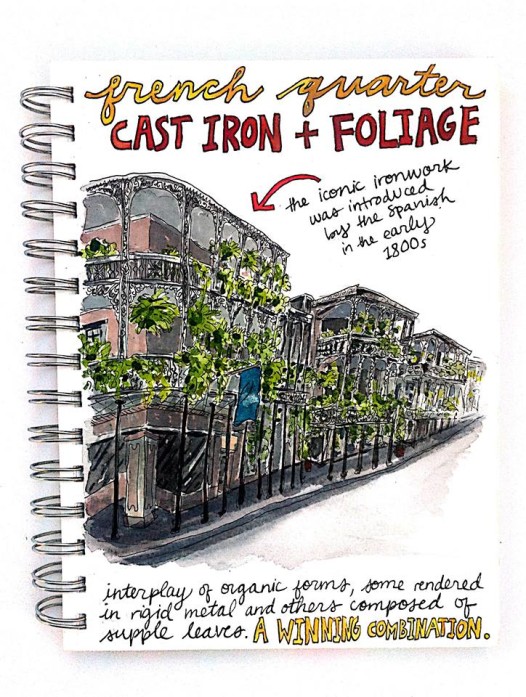Illustrator and writer Emma Fick is the published author of Snippets of Serbia. She is currently working on the illustrated book Snippets of New Orleans. To see more of Emma’s work and learn more about her, visit her website or find her on Instagram and Facebook.
We’ve all done it. We’ve had friends or family members in town, trudged (happily) down to the French Quarter during the height of tourist season, and we’ve looked up and said, “Isn’t that iron work just amazing?” Us, who bash the urine-lemon smell of the Quarter. Us, who rashly sneer when a newbie references the French Quarter as the best neighborhood in New Orleans. Us, who stare at Segway tours with such disdain that it should sometimes be labeled as a “hate crime look.”
That’s the thing about New Orleans architecture, though. It’s like that boyfriend or girlfriend from your past that was kind of annoying or not quite right, but for some reason you just kept being drawn back to them. You find yourself years past the relationship, but every time you see a photo or spark a memory you think, “Man, they were beautiful.” So what is it about the iron work that makes it so enchanting and entrancing?

Well…it’s Spanish, number one.
And, secondly, I’m a nerd about the brain, so we’re going to go into why we like those curves in a physiological sense. We as humans are drawn to the curve – just like those scrolls and curves that take our eyes from one post to the next in that iron work.
In fact, in repeated studies, when people are asked to choose between a linear object and a curved object, they prefer the curve. This was tested with watches, letters that had curves rather than straight lines, couches, and even dental floss with round packaging. Think about it. There are so many elements in nature that bring us serenity, peace, love, joy, and everything else they sang about in the 60s, and none – that’s right, none- of it is straight lines. It’s all curved. Hello evolution and getting back to our roots!
Now let’s get super sciency (I’m choosing to make that a word). Recently neuroscientists have found that this adoration and proclivity for curves isn’t just a matter of personal taste. It’s hard-wired into the brain.
Ready for another reference to a study? Well, here it is. It goes like this. At the University of Toronto at Scarborough some psychologists got together and showed photos to a sample of people. Some of the photos had furniture with – you guessed it- curved lines. The other photos had furniture and designs of hard, straight lines.
The curved spaces were rated “more beautiful” than the straight-lined rooms, but here is the more interesting part (the part that involves those sticky things attached to the head). Turns out that people looking at the photos with the curved design had way more activity in the anterior cingulate cortex (the part of the brain responsible for involvement with emotions). In other words, those curvy lines of the iron work tell our brains to tug on our hearts, proving once again that New Orleans is the most romantic city in the world.
And one more anecdote before we wipe our eyes with sentiment about our beloved city. When Philip Johnson, an amazing architect, first went to the Guggenheim Museum in Bilboa, which was designed by Frank Gehry, he started to cry. Then he said, “Architecture is not about words. It’s about tears.”
So you know what, New Orleans residents who look up at the iron work with cloudy eyes? Listen to the song below, dance a little, and cry, go on cry; cause that iron work is evolutionarily beautiful.
https://www.youtube.com/watch?v=oAIiZ6PV6W8
*Scientific studies were taken from Scientific American and Co.Design.
 NOLAbeings Multimedia artist Claire Bangser created NOLAbeings as a portrait-based story project that marries...
NOLAbeings Multimedia artist Claire Bangser created NOLAbeings as a portrait-based story project that marries...  Voodoo in New Orleans: Reviving history: New Orleans fortune telling This article takes a deep dive into the history of Voodoo in New Orleans, its hybridization with Catholicism, and its present-day place in the city's culture. The author visits fortune-tellers in the French Quarter, using their guidance as a tool for introspection rather than a deterministic predictor of the future. Through her experiences in New Orleans, the author feels a mystical connection to both the past and the future.
Voodoo in New Orleans: Reviving history: New Orleans fortune telling This article takes a deep dive into the history of Voodoo in New Orleans, its hybridization with Catholicism, and its present-day place in the city's culture. The author visits fortune-tellers in the French Quarter, using their guidance as a tool for introspection rather than a deterministic predictor of the future. Through her experiences in New Orleans, the author feels a mystical connection to both the past and the future. 